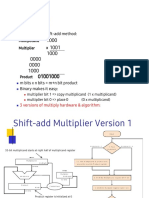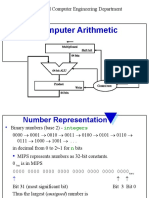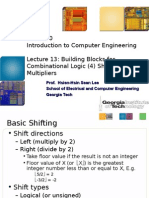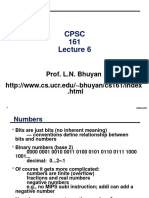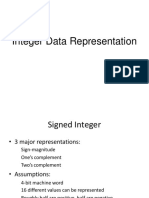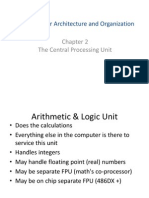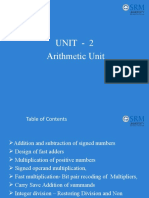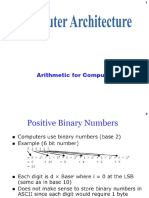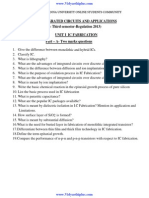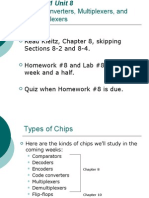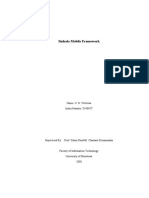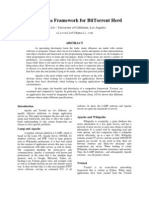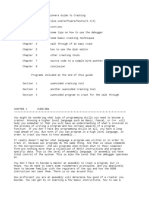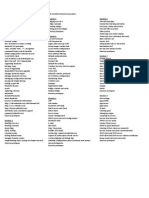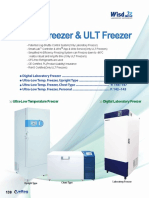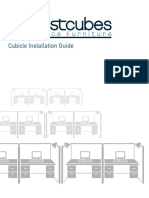COMPUTER ARITHMETIC
Jehan-Franois Pris
jparis@uh.edu
�Chapter Organization
Representing negative numbers
Integer addition and subtraction
Integer multiplication and division
Floating point operations
Examples of implementation
IBM 360, RISC, x86
�A warning
Binary addition, subtraction, multiplication and
division are very easy
�ADDITION AND SUBTRACTION
�General concept
Decimal addition
(carry) 1_
19
+ 7
26
Binary addition
( carry) 111_
10011
+ 111
11010
16+8+2 = 26
�Realization
Simplest solution is a battery of full adders
o s3
x3 y3
s2
x2 y2
s1
x1 y1
s0
x0 y0
�Observations
Adder add four-bit values
Output o indicates if there is an overflow
A result that cannot be represented using 4
bits
Happens when x + y > 15
Operation is slowed down by carry propagation
Faster solutions (not discussed here)
�Signed and unsigned additions
Unsigned addition in
4-bit arithmetic
( carry) 11_
1011
+ 0011
1110
11 + 3 = 14
(8 + 4 + 2)
Signed addition in
4-bit arithmetic
( carry) 11_
1011
+ 0011
1110
-5 + 3 = -2
�Signed and unsigned additions
Same rules apply even though bit strings
represent different values
Sole difference is overflow handling
�Overflow handling (I)
No overflow in signed
arithmetic
( carry) 111_
1110
+ 0011
0001
-2 + 3 = 1
(correct)
Signed addition in
4-bit arithmetic
( carry) 1__
0110
+ 0011
1001
6 + 3 -7
(false)
�Overflow handling (II)
In signed arithmetic an overflow happens when
The sum of two positive numbers exceeds
the maximum positive value that can be
represented using n bits: 2n 1 1
The sum of two negative numbers falls
below the minimum negative value that can
be represented using n bits: 2 n 1
�Example
Four-bit arithmetic:
Sixteen possible values
Positive overflow happens when result > 7
Negative overflow happens when result < -8
Eight-bit arithmetic:
256 possible values
Positive overflow happens when result > 127
Negative overflow happens when result < -128
�Overflow handling (III)
MIPS architecture handles signed and unsigned
overflows in a very different fashion:
Ignores unsigned overflows
Implements modulo 2n arithmetic
Generates an interrupt whenever it detects a
signed overflows
Lets the OS handled the condition
�Why?
To keep the CPU as simple and regular as
possible
�An interesting consequence
Most C compilers ignore overflows
C compilers must use unsigned arithmetic for
their integer operations
Fortran compilers expect overflow conditions to
be detected
Fortran compilers must use signed arithmetic
for their integer operations
�Subtraction
Can be implementing by
Specific hardware
Negating the subtrahend
�Negating a number
Toggle all bits then add one
�In 4-bit arithmetic (I)
0000
0001
0010
0011
0100
0101
0110
0111
0
1
2
3
4
5
6
7
1111
1110
1101
1100
1011
1010
1001
1000
+1 = 0000 0
+1 = 1111 -1
+1 = 1110 -2
+1 = 1101 -3
+1 = 1100 -4
+1 = 1011 -5
+1 = 1010 -6
+1 = 1001 -7
�In 4-bit arithmetic (II)
1000
1001
1010
1011
1100
1101
1110
1111
-8
-7
-6
-5
-4
-3
-2
-1
0111
0110
0101
0100
0011
0010
0001
0000
+1 =1000
+1 = 0111
+1 = 0110
+1 = 0101
+1 = 0100
+1 = 0011
+1 = 0010
+1 = 0001
?
7
6
5
4
3
2
1
�MULTIPLICATION
�Decimal multiplication
(carry) 1_
37
x 12
74
370
444
What are the rules?
Successively multiply the
multiplicand by each digit of the
multiplier starting at the right
shifting the result left by an
extra left position each time
each time but the first
Sum all partial results
�Binary multiplication
(carry)
111 _
1101
x 101
1101
00
110100
1000001
What are the rules?
Successively multiply the
multiplicand by each digit of
the multiplier starting at the
right shifting the result left by
an extra left position each
time each time but the first
Sum all partial results
Binary multiplication is easy!
�Binary multiplication table
X
�Algorithm
Clear contents of 64-bit product register
For (i = 0; i <32; i++) {
If (LSB of multiplier_register ==1)
Add contents of multiplicand register to product
register
Shift right one position multiplier register
Shift left one position multiplicand register
} / / for loop
�Multiplier: First version
Shift Left
Multiplicand (64 bits)
64-bit
ALU
Product (64 bits)
Shift Right
Multiplier
Control
�Multiplier: First version
Shift Left
As we(64
learned
Multiplicand
bits)
in grade school
64-bit
ALU
Product (64 bits)
Shift Right
Multiplier
To get next bit
( LSB to MSB)
Control
�Explanations
Multiplicand register must be 64-bit wide
because 32-bit multiplicand will be shifted 32
times to the left
Requires a 64-bit ALU
Product register must be 64-bit wide to
accommodate the result
Contents of multiplier register is shifted 32 times
to the right so that each bit successively
becomes its least significant bit (LSB)
�Example (I)
Multiply 0011 by 0011
Start
Multiplicand
Multiplier
0011
0011
Product
0000
First addition
Multiplicand
Multiplier
0011
0011
Product
0011
�Example (II)
Shift right and left
Multiplicand
Multiplier
0110
0001
Second addition
Multiplicand
Multiplier
0110
0001
0110 + 011 = 1001
Product
0011
Product
1001
�Example (III)
Shift right and left
Multiplicand
Multiplier
1100
0000
Product
1001
Multiplier is all zeroes: we are done
�First Optimization
Must have a 64-bit ALU
More complex than a 32-bit ALU
Solution is not to shift the multiplicand
After each cycle, the LSB being added
remains unchanged
Will save that bit elsewhere and shift the
product register one position to the left after
each iteration
�Binary multiplication
1101
x 101
1101
00
110100
1000101
Observe that the least
significant bit added during
each cycle remains
unchanged
�Algorithm
Clear contents of 64-bit product register
For (i = 0; i <32; i++) {
If (LSB of multiplier_register ==1)
Add contents of multiplicand register to
product register
Save LSB of product register
Shift right one position both multiplier
register and product register
} / / for loop
�Multiplier: Second version
Shift Right
Multiplicand
32-bit
ALU
Product (64 bits)
Multiplier
Control
+ Test
Shift Right and Save
�Decimal Example (I)
Multiply 27 by 12
Start
Multiplicand
Multiplier
27
12
Product
--
Result
--
First digit
Multiplicand
27
Product
54
Result
--
Multiplier
12
�Decimal Example (II)
Shift right multiplier and product
Multiplicand
Multiplier Product
27
1
5
Result
4
Second digit
Multiplicand
Multiplier
27
1
Result
4
Product
32
�Decimal Example (III)
Shift right multiplier and product
Multiplicand
Multiplier Product
27
0
3
Result
24
Multiplier equals zero
Result is obtained by concatenating contents of
product and result registers
324
�How did it work?
We learned
2712 = 2710 + 272
= 2710 + 54
= 270 + 54
Algorithm uses another decomposition
2712 = 2710 + 272
= 2710 + 50 + 4
= (2710 + 50) + 4
= 320 + 4
�Example (I)
Multiply 0011 by 0011
Start
Multiplicand
Multiplier
0011
0011
Product
--
Result
--
First bit
Multiplicand
0011
Product
0011
Result
--
Multiplier
0011
�Example (II)
Shift right multiplier and product
Multiplicand
Multiplier Product
0011
0001
0001
Result
1-
Second bit
Multiplicand
Multiplier Product
Result
0011
0001
0100
1Product register contains 0011 + 001 = 0100
�Example (III)
Shift right multiplier and product
Multiplicand
Multiplier Product
0011
0000
010
Result
01-
Multiplier equals zero
Result is obtained by concatenating contents of
product and result registers
1001 = 9
�Second Optimization
Both multiplier and product must be shifted to
one position to the right after each iteration
Both are now 32-bit quantities
Can store both quantities in the product register
�Multiplier: Third version
Multiplicand
32-bit
ALU
Multiplier + Product
Control
+ Test
Shift Right and Save
�Third Optimization
Multiplication requires 32 additions and 32 shift
operations
Can have two or more partial multiplications
One using bits 0-15 of multiplier
A second using bits 16-31
then add together the partial results
�Multiplying negative numbers
Can use the same algorithm as before but we
must extend the sign bit of the product
�Related MIPS instructions (I)
Integer multiplication uses a separate pair of
registers (hi and lo)
mult $s0, $s1
multiply contents of register $s0 by contents
of register $s1 and store results in register
pair hi-lo
multu $s0, $s1
same but unsigned
�Related MIPS instructions (II)
mflo $s9
Move contents of register lo to register $s0
mfhi $s9
Move contents of register hi to register $s0
�DIVISION
�Division
Implemented by successive subtractions
Result must verify the equality
Dividend = Multiplier Quotient + Remainder
�Decimal division (long division
7
303
2126
-210
26
-21
5
What are the rules?
Repeatedly try to subtract smaller
multiple of divisor from dividend
Record multiple (or zero)
At each step, repeat with a lower
power of ten
Stop when remainder is smaller
than divisor
�Binary division
11
011
1011
-11
X
1011
What are the rules?
Repeatedly try to subtract powers
of two of divisor from dividend
Mark 1 for success, 0 for failure
At each step, shift divisor one
position to the right
>11
Stop when remainder is smaller
than divisor
101
>>-11
�Same division in decimal
3
2+1=3 What are the rules?
11
Repeatedly try to subtract powers
of two of divisor from dividend
-12
X
Mark 1 for success, 0 for failure
11
>-6
5
>-3
2
At each step, shift divisor one
position to the right
Stop when remainder is smaller
than divisor
�Observations
Binary division is actually simpler
We start with a left-shifted version of divisor
We try to subtract it from dividend
No need to find out which multiple to subtract
We mark 1 for success, 0 for failure
We shift divisor one position left after every
attempt
�How to start the division
One 64-bit register for successive remainders
Initialized with dividend
One 64-bit register for divisor
Quotient
Start with quotient in upper half
One 32-bit register for the quotient
All zeroes
�How we proceed (I) After each step we shift the quotient to the right
one position at a time
Divisor
Divisor
Div isor
Divisor
�How we proceed (II)
After each step we shift the contents of the
quotient register one position to the left
To make space for the new 0 or 1 being
inserted
0
01
011
0110
�Division Algorithm
For i in range(0,33) :
# from 0 to 32
Subtract contents of divisor register from
remainder register
If remainder 0 :
Shift quotient register to the left
Set new rightmost bit to 1
Else :
Undo subtraction
Shift quotient register to the left
Set new rightmost bit to 0
Shift right one position contents of divisor register
�A simple divider
Shift Right
Divisor (64 bits)
64-bit
ALU
Remainder (64 bits)
Shift Left
Quotient
Control
+ Test
�Signed division
Easiest solution is to remember the sign of the
operands and adjust the sign of the quotient and
remainder accordingly
A little problem:
5 2 = 2 and the remainder is 1
-5 2 = -2 and the remainder is -1
The sign of the remainder must match the sign
of the quotient
�Related MIPS instructions
Integer division uses the same pair of registers
(hi and lo) as integer multiplication
div $s0, $s1
divide contents of register $s0 by contents of
register $s, leave the quotient in register lo
and the remainder in register hi
divu $s0, $s1
same but unsigned
�TRANSITION SLIDE
Here end the materials that were on the first fall
2012 midterm
Here start the materials that will be on the fall
2012 midterm
To be moved to
the right place
�FLOATING POINT OPERATIONS
�Floating point numbers
Used to represent real numbers
Very similar to scientific notation
3.5106, 0.82105, 75106,
Both decimal numbers in scientific notation and
floating point numbers can be normalized:
3.5106, 8.2106, 7.5107,
�Fractional binary numbers
0.1 is or 0.5ten
0.01 is 0.1 is 1/4 or 0.25ten
0.11 is + = or 0.75ten
1.1 is 1 or 1.5ten
10.01 is 2 + or 2.5ten
11.11 is ______ or _____
�Normalizing binary numbers
0.1 becomes 1.02-1
0.01 becomes 1.02-2
0.11 becomes 1.12-1
1.1 is already normalized and equal to1.020
10.01 becomes 1.00121
11.11 becomes 1______2_____
�Representation
Sign + exponent + coefficient
SExp
Coefficient
IEEE Standard 754
1 + 8 + 23 = 32 bits
1+ 11 + 52 = 64 bits (double precision)
�The sign bit
0 indicates a positive number
1 a negative number
�The exponent (I)
8 bits for single precision
11 bits for double precision
With 8 bits, we can represent exponents between
-126 and + 127
All-zeroes value is reserved for the zeroes and
denormalized numbers
All-ones value are reserved for the infinities and
NaNs (Not a Number)
�The exponent (II)
Exponents are represented using a biased
notation
Stored value = actual exponent + bias
For 8 bit exponents, bias is 127
Stored value of 1 corresponds to 126
Stored value of 254 corresponds to +127
0 and 255 are reserved for special values
�The exponent (III)
Biased notation simplifies comparisons:
If two normalized floating point numbers
have different exponents, the one with the
bigger exponent is the bigger of the two
�Special values (I)
Signed zeroes:
IEEE 754 distinguishes between +0 and 0
Represented by
Sign bit: 0 or 1
Biased exponent: all zeroes
Coefficient: all zeroes
�Special values (II)
Denormalized numbers:
Numbers whose coefficient cannot be
normalized
Smaller than 2126
Will have a coefficient with leading zeroes and
exponent field equal to zero
Reduces the number of significant digits
Lowers accuracy
�Special values (III)
Infinities:
+ and
Represented by
Sign bit: 0 or 1
Biased exponent: all ones
Coefficient: all zeroes
�Special values (IV)
NaN:
For Not a Number
Often result from illegal divisions:
0/0, /, /, /, and /
Represented by
Sign bit: 0 or 1
Biased exponent: all ones
Coefficient: non zero
�The coefficient
Also known as fraction or significand
Most significant bit is always one
Implicit and not represented
0011000000000000000000000000
Biased exponent is 127ten
True coefficient is implicit one followed by all
zeroes
�Decoding a floating point number
Sign indicated by first bit
Subtract 127 from biased exponent to obtain
power of two:
<be> 127
Use coefficient to construct a normalized binary
value with a binary point:
1.<coefficient>
Number being represented is
1.<coefficient> 2<be> 127
�First example
0 011 00000000000000000000000000000
Sign bit is zero:
Number is positive
Biased exponent is 127
Power of two is zero
Normalized binary value is
1.0000000
Number is 120 = 1
�Second example
0 100 10000000000000000000000000000
Sign bit is zero:
Number is positive
Biased exponent is 128
Power of two is 1
Normalized binary value is
1.1000000
Number is 1.121 = 11 = 3ten
�Third example
1 011011000000000000000000000000000
Sign bit is 1:
Number is negative
Biased exponent is 126
Power of two is 1
Normalized binary value is
1.1100000
Number is 1.1121 = 0.111 = 7/8ten
�Can we do it now?
0
129ten
10100000000000000000000000000
Sign bit is 0:
Number is ___________
Biased exponent is 129
Power of two is _______
Normalized binary value is
1.__________
Number is _________________________
�Encoding a floating point number
Use sign to pick sign bit
Normalize the number:
Convert it to form 1.<more bits> 2<exp>
Add 127 to exponent <exp> to obtain
biased exponent <be>
Coefficient <coeff> is equal to fractional part
<more bits> of number
�First example
Represent 7:
Convert to binary: 111
Normalize: 1.1122
Sign bit is 0
Biased exponent is 127 + 2 = 10000001two
Coefficient is
11000
0 1001 11000000000000000000000000000
�Second example
Represent 1/2
Convert to binary: 0.1
Normalize: 1.02-1
Sign bit is 0
Biased exponent is 127 1 = 01111110two
Coefficient is 000
0 011000000000000000000000000000000
�Third example
Represent 2
Convert to binary: 10
Normalize: 1.021
Sign bit is 1
Biased exponent is 127 + 1 = 10000000two
Coefficient is 000
1 100000000000000000000000000000000
�Fourth example
Represent 9/4
Convert to binary: 100122
Normalize: 1.00121
Sign bit is 0
Biased exponent is 127 + 1 = 10000000two
Coefficient is 00100
1 100000100000000000000000000000000
�Can we do it now?
Represent 6.25:
Convert to binary: ________
Normalize: 1.______2_______
Sign bit is _____
Biased exponent is 127 + ___ = ______ten
Coefficient is_________
�Range
Can represent numbers between
1.0002126 and 1.1112127
Say between 2126 and 2128
Observing that 210 103
we divide the exponents by 10 and multiply them
by 3 to obtain the interval expressed in powers of
10
Approximate range is 1038 to 1038
�Accuracy
We have 24 significant bits
Theoretical precision of 1/224, that is, roughly
1/107
Cannot add correctly billions or trillions
Actual situation is worse if we do too many
computations
1,000,000 999,999.4875 = ???
�Guard bits
Do all arithmetic operations with two additional
bits to reduce rounding errors
�Double precision arithmetic (I)
Use 64-bit double words
Allows us to have
One bit for sign
Eleven bits for exponent
2,048 possible values
Fifty-two bits for coefficient
Plus the implicit leading bit
�Double precision arithmetic (II)
Exponents are still represented using a biased
notation
Stored value = actual exponent + bias
For 11-bit exponents, bias is 1023
Stored value of 1 corresponds to 1,022
Stored value of 2,046 corresponds to +1,023
Stored values of 0 and 2,047 are reserved for
special cases
�Double precision arithmetic (III)
Can now represent numbers between
1.00021,022 and 1.11121,203
Say between 21,022 and 21,204
Approximate range is 10307 to 10307
In reality, more like 10308 to 10308
�Double precision arithmetic (IV)
We now have 53 significant bits
Theoretical precision of 1/253. that is, roughly
1/1016
Can now add correctly billions or trillions
�If that is now enough,
Can use 128-bit quad words
Allows us to have
One bit for sign
Fifteen bits for exponent
From 16382 to +16383
One hundred twelve bits for coefficient
Plus the implicit leading bit
�Decimal floating point addition (I)
5.25103 + 1.22102 = ?
Denormalize number with smaller exponent:
5.25103 + 0.122103
Add the numbers:
5.25103 + 0.122103 = 5.372103
Result is normalized
�Decimal floating point addition (II)
9.25103 + 8.22102 = ?
Denormalize number with smaller exponent:
9.25103 + 0.822103
Add the numbers:
9.25103 + 0.822103 = 10.072103
Normalize the result:
10.072103 = 1.0072104
�Binary floating point addition (I)
Say 1001 + 10 or 1.00123 + 1.021
Denormalize number with smaller exponent:
1.00123 + 0.0123
Add the numbers:
1.00123 + 0.0123 = 1.01123
Result is normalized
�Binary floating point addition (II)
Say 101 + 11 or 1.0122 + 1.121
Denormalize number with smaller exponent:
1.0122 + 0.1122
Add the numbers:
1.0122 + 0.1122 = 10.0022
Normalize the results
10.0022 = 1.00023
�Binary floating point subtraction
Say 101 11 or 1.0122 1.121
Denormalize number with smaller exponent:
1.0122 0.1122
Perform the subtraction:
1.0122 0.1122 = 0.1022
Normalize the results
0.1022 = 1.021
�Decimal floating point multiplication
Exponent of product is the sum of the exponents
of multiplicand and multiplier
Coefficient of product is the product of the
coefficients of multiplicand and multiplier
Compute sign using usual rules of arithmetic
May have to renormalize the product
�Decimal floating point multiplication
6103 2.5102 = ?
Exponent of product is:
3+2=5
Multiply the coefficients:
6 2.5 = 15
Result will be positive
Normalize the result:
15105 = 1.5106
�Binary floating point multiplication
Exponent of product is the sum of the exponents
of multiplicand and multiplier
Coefficient of product is the product of the
coefficients of multiplicand and multiplier
Compute sign using usual rules of arithmetic
May have to renormalize the product
�Binary floating point multiplication
Say 110 11 or 1.122 1.121
Exponent of product is:
2+1=3
Multiply the coefficients:
1.1 1.1 = 10.01
Result will be positive
Normalize the result:
10.0123 = 1.00124
�FP division
Very tricky
One good solution is to multiply the dividend by
the inverse of the divisor
�A trap
Addition does not necessarily commute:
91037 + 91037 + 410-37
Observe that
(91037 + 91037) + 410-37 = 410-37
while
91037 + (91037+ 410-37) = 0
due to the limited accuracy of FP numbers
�IMPLEMENTATIONS
�The floating-point unit (I)
Floating-point instructions were an optional
feature
User had to buy a separate floating-point unit
aka floating point coprocessor
Before Intel 80486, all Intel x86
architectures the option to install a separate
floating-point chip(8087, 80287, 80387)
�The floating-point unit (II)
Default solution was to simulate the missing
floating-point instructions through assembly
routines
As a result, many processor architectures use
separate banks of registers for integer arithmetic
and floating point arithmetic
�The floating-point unit (III)
Some older architectures implemented
Single-precision operations in hardware
through the FPU
Double-precision operations by software
Made double-precession operations much
costlier than single-precision operations.
�IBM 360 FP INSTRUCTIONS
�Overview
FPU offers a very familiar user interface
Eight general purpose FP registers
Distinct from the integer registers
Two-operand instructions in both RR and RX
formats
Includes single-precision and double-precision
versions or addition, subtraction, multiplication
and division
�Examples of RR instructions
AFR f1, f2
add contents of floating-point
register f2 into f1
ADR f1,f2
add contents of double-precision
register f2 into f1
LFR f1, f2
load contents of floating-point
register f2 into f1
Also had load positive, load negative, load
complement instructions for floating-point and
double-precision operands
�Examples of RX instructions
AF r1, d(r2)
AD r1,d(r2)
add contents of word at address
d + contents(r2) into register r1
�MIPS FP INSTRUCTIONS
�Overview
Thirty-two specialized single-precision registers:
$f0, $f1, $f31
Each pair of single-precision registers forms a
double-precision register
*.s instructions apply to single precision format
*.d instructions apply to double precision format
Most instructions are in the R format
�R-format instructions (I)
add.s f1, f2, f3 f1 = r2 + f3 (single precision)
add.d f2, f4, f6 (f2, f2+1) = (f4, f4+1) + (f6, f6 +1)
(double precision applies to
register pairs)
sub.s f1, f2, f3 f1 = f2 f3 (single precision)
sub.d f2, f4, f6 (double precision)
mul.s f1, f2, f3 f1 = f2f3 (single precision)
mul.d f2, f4, f6 (double precision)
�R-format instructions (II)
div.s f1, f2, f3 f1 = f2 /f3 (single precision)
div.d f2, f4, f6 (double precision)
c.x.s f1, f2
FP condition = f1 x f2 ? 1 ! 0
where x can be equal, not equal,
less than, less than or equal,
greater than, greater than or equal
c.x.d f2, f4
(double precision)
�I-format instructions (I)
bclt a
bclf a
jump to address computed by
adding 4a to the current value of
the PC if the FP condition is true
jump to address computed by
adding 4a to the current value of
the PC if the FP condition is false
�I-format instructions (I)
lwcl f1, a(r1) load floating-point word at address
a + contents(r1) into f1
ldcl f2, a(r1) (double precision)
swcl f1, a(r1) store floating-point value in f1
into word at address
a + contents(r1)
sdcl f2, a(r1) (double precision)
The "c" in the opcodes stands for coprocessor!
�x86 FP INSTRUCTIONS
�Overview
Original x86 FP coprocessor had a stack
architecture
Stack registers were 80-bit wide as well as all
internal registers
Better accuracy
Provided single and double precision operations
�Stack operations (I)
Three types of operations:
Loads store an operand on the top of the stack
Arithmetic and comparison operations find
two operands of the top of the stack and
replace them by the result of the operation
Stores move the top of stack register into
memory
�Example
a=b+c
Load b on top of stack
Load c on top of stack
Add c to b
Store result into a
b
b
----c
b
b
----b+c
-----
�Stack operations (II)
Instruction set also allowed
Operations on top of stack register and the ith
register below
Immediate operands
Operations on top of stack register and a memory
location
Poor performance of FP unit architecture motivated
an extension to the x86 instruction set
�Intel SSE2 FP Architecture (I)
SSE2 Extension (2001) provided 8 floating point
registers
Could hold either single precision or double
precision values
Number extended to 16 by AMD, followed by
Intel
�Intel SSE2 FP Architecture (II)
Registers are now 128-bit wide
Wow!
Can hold
One quad precision value
Two double precision values
Four single precision values
Can perform same operation in parallel on all
single/double precision values stored in the same
register
�REVIEW QUESTIONS
�Review questions
How would you represent 0.5 in double precision?
How would you convert this double-precision
value into a single precision format?
When doing accounting, we could do all the
computations in cents using integer arithmetic.
What would we win? What would we lose?
�Solutions
How would you represent 0.5 in double precision?
Normalized representation: 1.0 2-1
Sign: 0
Biased exponent: 1023 1 = 1022
Coefficient: All zeroes
Because the 1 is implicit
�Solutions
How would you convert this double-precision value
into a single precision format?
Same normalized representation: 1.0 2-1
Same sign: 0
New biased exponent: 127 1 = 126
Same coefficient: All zeroes
Because the 1 is implicit
�Solutions
When doing accounting, we could do all the
computations in cents using integer arithmetic. What
would we win? What would we lose?
Big plus:
The results would be exact
Big minus:
Could not handle numbers bigger than
$20,000,000 in 32-bit signed arithmetic
�Why $20,000,000?
32-bit unsigned arithmetic can represent
numbers from 0 to 232 1
32-bit unsigned arithmetic can represent
numbers from -231 to 231 1
Roughly from -2000,000,000 to 2,000,000,000
Must divide by 100 as we were using cents!
�TRANSITION SLIDE
Here end the materials that were on the first fall
2012 midterm






